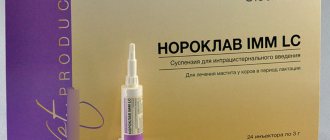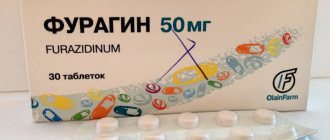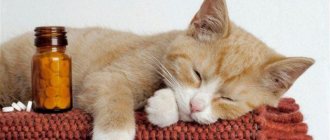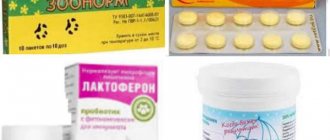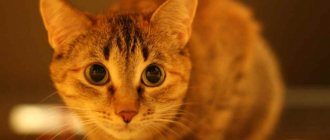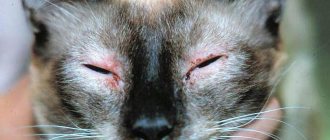7712Pavel
The expression “a cat has nine lives” allows many people to believe that these animals are extremely unpretentious and have stable immunity. In fact, cats are vulnerable to various infections, bacteria, viruses, and become seriously ill.
Amoxiclav for cats is prescribed when infectious diseases occur. The use of the drug is indicated to prevent the development of suppuration of wounds, postoperative sutures, and in other critical situations associated with wounds and trauma to the skin and soft tissues of the animal.
© shutterstock
Release form
- Amoxiclav tablets 375 mg - amoxicillin trihydrate 250 mg; clavulanic acid 125 mg. Suitable for cats
- Tablets 625 mg - amoxicillin trihydrate 500 mg; clavulanic acid 125 mg. Not suitable for use by cats.
- 1000 mg tablets - amoxicillin trihydrate 875 mg, clavulanic acid 125 mg. Not suitable for use on cats.
- Amoxiclav powder for the preparation of a suspension for oral administration, 5 ml of suspension contains (156.25 mg): amoxicillin trihydrate 125 mg; clavulanic acid 31.25 mg. Convenient to dose for cats. Your pet will not like the strawberry taste.
- Powder for the preparation of a suspension for oral administration. 5 ml of suspension contains 312.5 mg: amoxicillin 250 mg; clavulanic acid 62.5 mg. You can dose it, cats don’t really like the cherry taste.
- Powder for the preparation of a suspension for oral administration, 5 ml of suspension contains 475 mg of active substances: amoxicillin 400 mg; clavulanic acid 57 mg Can be dosed in cats.
- Amoxiclav powder for the preparation of solution for intravenous administration, 1 bottle contains 600 mg of the following active substances: amoxicillin 500 mg; clavulanic acid 100 mg. An economically more feasible option for cats.
- Powder for solution for intravenous administration 1 bottle contains 1200 mg of the following active substances. Active ingredients: amoxicillin - 1000 mg; clavulanic acid - 200 mg. Most of the drug will be thrown away - it is not profitable to use for treating cats
"Amoxicillin" for cats: methods of administration and dosage
We mentioned above that Amoxicillin is sold in three forms: tablets, suspension and injection solution. The last two are most preferable from a therapeutic point of view, since they do not affect the stomach and intestines of the animal, are absorbed faster and remain effective longer. In addition, the animal may vomit the tablet when the owner does not see it, and the therapeutic effect will be lost. This cannot happen with an injection.
Amoxicillin solution and suspension are administered intramuscularly or subcutaneously; usually the injection is given once, approximately once every two days. The drug is calculated based on the weight of the animal: 15 milligrams of the drug are set per kilogram of weight (15 mg/1 kg).
When using Amoxicillin in tablet form, you need to proceed from the following calculation: 12.5 milligrams per kilogram of cat weight (12.5 mg/1 kg). If necessary, the tablet should be divided into parts.
Video - How to give an injection to an animal?
History of antibiotic use
Thanks to the work of Alexander Fleming (1881–1955), Howard Florey (1898–1968), and Ernst Chain (1906–1979), penicillin was first produced on a large scale for human use in 1943. At the time, the development of antibiotics that could reliably kill bacteria was a medical breakthrough, and many people were saved during World War II because these drugs became available.
But it soon became obvious that penicillin had a number of disadvantages. For example:
Penicillin is poorly absorbed from the intestinal tract, meaning that at least 70% of the oral dose is wasted.
Penicillin is also a short-acting drug, with half the circulating amount being eliminated from the body every half hour.
Not all bacteria have the type of cell wall that is susceptible to destruction by penicillin. (Bacteria are classified as gram-negative or gram-positive, depending on the characteristics of the cell wall. Penicillin can disrupt the integrity of the cell membrane in gram-positive bacteria, but it is not very effective against gram-negative microbes.
Staphylococci, an important group of pathogenic bacteria, during penicillin therapy began to secrete an enzyme called penicillinase to break down the antibiotic molecule and thus became resistant to antimicrobial agents. Amoxicillin is a synthetic modification of the original penicillin molecule. Amoxicillin resists the effects of gastric acid better, so less of the oral dose is wasted. Although it is still susceptible to destruction by staphylococcal enzymes, it has a much broader spectrum of activity against the cell wall of gram-negative bacteria and is able to act somewhat longer than natural penicillins.
Amoxiclav is the answer to the problem of staphylococcus resistance. By adding "Clavulanic acid", the structure of penicillin was protected from bacterial enzymes and this antibiotic can be effectively used against staphylococcal infections.
Combination of amoxicillin and clavulanic acid in amoxiclav
definitely solves the problem with staphylococci: it blocks the enzymes beta-lactamase and penicillinase, which destroy penicillin antibiotics. Clavulanate protects amoxicillin by binding to these bacterial enzymes so they cannot destroy the antibiotic's beta-lactam ring structure that makes the penicillin molecule so effective.
In short, the combination of clavulanic acid and amoxicillin allows amoxiclav to kill staphylococci, whereas regular amoxicillin would be ineffective.
Instructions for use
An antibiotic can be used for cats only after consultation with a veterinarian, who will assess the pet’s condition, make an accurate diagnosis, weigh the purr, and only then prescribe the dosage and determine the required duration of the treatment course. When prescribing Amoxiclav in powder form, it will need to be pre-mixed with water and administered into the cat’s mouth. The suspension is used for intramuscular and subcutaneous injections. Antibiotic tablets should be given to the pet in a dosage of 12.5 mg of medication per kg of weight, twice a day. The duration of treatment usually ranges from 5 to 28 days. depending on the diagnosis. In this case, the therapeutic effect is achieved on average in 6 days.
Doses of amoxiclav for cats
- Amoxiclav tablets 375 mg - amoxicillin trihydrate 250 mg; clavulanic acid 125 mg. Dose for a cat: 5 kg of weight, 1/5 t, 2 times a day for 5-14 days. For severe skin infections, the dose may be 1/3 tablet 2 times a day for 14 days.
- Amoxiclav powder for the preparation of a suspension for oral administration is contained in 5 ml of suspension (156.25 mg). A cat weighing 5 kg should be given 2 ml of suspension 2 times a day for 5-14 days. Dermatological doses are 2 times higher.
- Powder for the preparation of a suspension for oral administration, 5 ml of suspension contains 312.5 mg. A cat weighing 5 kg should be given 1 ml of suspension 2 times a day for 5-14 days. Dermatological doses are 2 times higher.
- Powder for the preparation of a suspension for oral administration, 5 ml of suspension contains 475 mg of active substances: amoxicillin 400 mg; clavulanic acid 57 mg Can be dosed in cats. A cat weighing 5 kg should be given 0.65 ml of suspension 2 times a day for 5-14 days. Dermatological doses are 2 times higher.
- Amoxiclav powder for the preparation of solution for intravenous administration, 1 bottle contains 600 mg of the following active substances. For cats with severe illnesses in doses of 12.5 - 25 mg / kg intravenously 2 times a day for 5-10 days. The diluted drug can be stored in the refrigerator for no more than 12 hours.
Reviews about “Amoxiclav (suspension, tablets) for cats and dogs”:
The kitten was vomiting and had loose stools and was prescribed amoxiclav suspension for children; they gave it 3 days and everything seemed to be back to normal.
Reply [x] Cancel reply
I picked up an adult cat on the street with a lot of problems. It is pointless to list everything; the infection affected both the lungs and the bladder, and the cat was bleeding from the eyes and ears. The veterinarian recommended amoxiclav, a modern antibiotic. The tablet was divided into parts, mixed with pate and fed to the cat. She was willing to eat anything, so there were no problems. They gave it twice a day for a week. Improvement came very quickly, but the course was taken completely, in combination with other drugs. True, the better the cat became, the less appetite she ate the pate with the antibiotic. But as a last resort, the veterinarian recommended that we dissolve amoxiclav in water and spray it from a syringe into our mouth. I’m very pleased with the result, and I’m also pleased with the fact that amoxiclav can also be bought in a human pharmacy; in our city there is only one veterinary pharmacy and its assortment is poor. According to the test results, the cat is healthy, so the drug has an effect.
Reply [x] Cancel reply
This spring my dog got sick. It all started with the fact that she began to constantly ask to go for a walk, rushed along the corridor, ran up to me, then ran to the front door, that is, in every way available to her, she invited me to go for a walk. Naturally, I took her outside and watched her sit down small many times, while she did not urinate a lot. I began to peer into the urine and found streaks of blood in it. That same day we went to the veterinary clinic for urine and blood tests. When I collected urine into a jar, I saw that the urine was not only streaked with blood, but also terribly cloudy. Based on the results of a blood test and urine test, the dog was diagnosed with acute cystitis. We were prescribed the antibiotic amoxiclav 1000 mg. twice a day (this is for a large dog, 55 kg). We started taking the drug on the same day, of course we still suffered through the night with endless urges to pee, but by the morning the dog felt much better, we took a calm walk (the dog no longer sat down to pee every meter). The course of treatment was 5 days.
Reply [x] Cancel reply
One day we encountered a staphylococcal infection in a dog. Externally, this disease manifested itself in the form of bald patches on the body, in which itchy and suppurating spots appeared. The dog was treated for a very long time for food allergies, until the new veterinarian insisted on taking a culture, which revealed staphylococcus. In addition to the ointment, the antibiotic Amoxiclav was prescribed. The dosage was calculated based on the dog’s weight and it turned out to be a quarter of a tablet. The tablets themselves are oblong and easy to divide. I crushed the resulting quarter tablets into powder (the easiest way is to crush them in a mortar) and mixed them into my favorite canned food. The powder is bitter, but there is so little of it, and there is so much canned food that the dog never noticed the catch. We gave amoxiclav twice a day. I can’t say that the effect of the drug came very quickly; perhaps, of course, the reason was an advanced disease, but the initial seven-day course had to be extended for another week, after which the antibiotic was no longer required. Amoxiclav is a powerful antibiotic with a broad spectrum of action and is truly effective. The main thing is without self-medication.
Amoxicillin is a veterinary antibacterial drug with a wide spectrum of action. It is often used in the treatment of respiratory diseases, as well as pathologies of the digestive and genitourinary systems caused by harmful microorganisms. It is highly effective and is considered one of the safest antibiotics for dogs.
Most often, an antibiotic is used for dogs in the form of a suspension intended for intramuscular or subcutaneous injection. The outwardly white liquid is packaged in glass bottles, which are sealed with rubber stoppers and rolled up with aluminum lids to maintain tightness. The composition of the drug is based on amoxicillin in the form of trihydrate. Its concentration in the drug is 150 mg per 1 ml of suspension. It also contains an oily filler. It performs a special role - it ensures the long-term effect of the main component.
Note! You can store the medicine in an opened bottle for no more than 28 days.
The antibacterial agent is also available in the following pharmacological forms:
- Pills. May contain 0.25 and 0.5 g of active ingredient. The tablets are resistant to gastric juice and are quickly absorbed from the gastrointestinal tract.
- Powder for oral administration. The concentration of the active substance is 150 mg of amoxicillin per gram of powder. Packaged in polymer bags of various volumes - from 1 g to 1 kg.
The main active substance amoxicillin is a semisynthetic antibiotic of the penicillin series. Its main advantage is its wide spectrum of action. The drug is active against various gram-positive and gram-negative bacteria. These include:
- streptococci;
- staphylococci;
- salmonella;
- enterobacter;
- pseudomonas;
- erysipeloids;
- pasteurella;
- listeria, etc.
A complete list of bacteria against which Amoxicillin is effective when used in dogs can be read in the instructions included with the medication.
Interaction with other drugs
When the organism in a serious infection in cats cannot be isolated, the general strategy is to try to cover up all possible bacteria. The amoxicillin-clavulanate combination is often used concomitantly with other antibiotics for this purpose. It is believed that there is a synergistic effect between amoxiclav and representatives of the quinolone class of antibiotics (enrofloxacin, ciprofloxacin, levofloxacin, marbofloxacin, orbifloxacin, etc.) - they enhance each other’s effect.
Methotrexate, a common chemotherapy drug in cats, may increase its blood concentration to toxic levels when used concomitantly with amoxiclav.
Negative phenomena and possible limitations
Veterinarians warn pet owners that taking Amoxiclav can provoke various undesirable effects, including:
- cardiopalmus;
- allergic reactions in the form of skin itching, increased lacrimation, allergic rhinitis;
- diarrhea, vomiting and other changes in the functioning of the digestive system;
- dyspnea;
- impaired coordination of movements.
If any of the listed signs occur, it will be necessary to show the cat to a veterinarian, who will adjust the therapeutic regimen or replace Amoxiclav with a similar medication. Despite the relatively good tolerance of the antibiotic and its high effectiveness, the use of Amoksiklav is not always permitted. So, you will need to discard the antibacterial drug if the kitten is less than 6 weeks old. Amoxiclav is also contraindicated for pets with the following conditions:
Lactating females should not be prescribed this drug.
- pregnancy;
- lactation;
- kidney and liver diseases;
- problems in the hematopoietic system.
Veterinarians do not prescribe the antibacterial medication in question to cats that were previously treated with penicillin-type medications. Otherwise, cumulative effects, overdose and allergic reactions are possible. The appropriateness of using Amoxiclav is determined by a veterinarian on an individual basis for each cat.
Special Cautions
The oral suspension should be stored in the refrigerator, although if it is mistakenly left out of the refrigerator for one day, this is not a problem. The oral suspension should be discarded 10 days after reconstitution.
Amoxiclav can be given to cats with or without food.
Amoxicillin + clavulanic acid crosses the placenta in pregnant cats, but is considered safe for use during pregnancy.
In recent years, staphylococci have developed resistance genes beyond simply producing penicillinase. These new bacteria are called methicillin-resistant staphylococci, and they are simply resistant to the penicillin group of antibiotics (and usually also to the cephalosporin group of antibiotics). If bacterial resistance to amoxiclav is suspected (or even if staphylococci are suspected), it may be wise to culture the organism and obtain a profile of appropriate antibiotics so as not to waste time on something ineffective. Methicillin-resistant staphylococci are resistant to the combination of amoxicillin and clavulanic acid, so something else will need to be chosen.
Human formulations contain varying amounts of amoxicillin and clavulanic acid, and strengths are usually expressed only in the amount of amoxicillin present. This means that it may be difficult to find a human drug that is truly comparable to its veterinary equivalent (Sinulox).
To whom is it assigned?
If an animal’s suture does not heal well after surgery, then it may be prescribed such a drug.
The effectiveness of the combined antibiotic in the treatment of cats has been proven by many scientists who study the effects of human antibacterial drugs on the animal body. Thus, tablets and suspension are prescribed to pets when an infection develops in the upper respiratory tract, stomach, intestines, urinary system and genital area. “Amoxiclav” gives excellent results for cats that have purulent wounds and poorly healing postoperative sutures.
Contraindications, side effects, precautions when using amoxiclav in cats
- Do not prescribe amoxiclav to cats with an allergy to penicillin or to pets with impaired liver function during previous treatment.
- Use with caution in patients allergic to cephalosporins (cross-sensitivity may occur), patients with liver failure or severe renal impairment (reduce dosage and give every 12-24 hours).
- May cause diarrhea; liver disease (avoid treatment for longer than 14 days); allergic reactions are sometimes severe.
- Do not combine with methotrexate (increased toxicity of methotrexate).
- Pregnancy: no contraindications
- Breastfeeding period for kittens: no contraindications
Side effects and contraindications
When used in recommended doses, side effects usually do not occur. But allergies are possible.
Contraindications:
- sensitivity to penicillins;
- use in laying hens whose eggs are consumed by humans;
- use in rabbits, guinea pigs, hamsters and other rodents.
- for liver and kidney diseases;
- for diseases of the hematopoietic system;
- in pregnant females;
The slaughter of poultry is allowed after two days, pigs - after three days after discontinuation of amoxiclav.
Pharmacokinetics of amoxiclav in cats
One study examined the pharmacokinetic properties of amoxicillin (AMX) and clavulanic acid (CLV) in healthy cats following single intravenous and oral administration of 10 mg/kg AMX and 2.5 mg/kg CLV.
Plasma drug concentrations were determined by high-performance liquid chromatography-tandem mass spectrometry (LC-MS-MS) validated for canine plasma and then subjected to non-commercial analysis. After intravenous injection, no significant difference (p>0.05) was found in the volume of distribution of the two compounds. In addition, AMX and CLV were rapidly cleared from plasma with clearances of 0.453 and 0.921 L/h-1 kg-1, respectively; however, faster clearance was observed for CLV (p
Following oral administration, both drugs were rapidly absorbed with half-lives of 1.10 and 0.70 hours for AMX and CLV, respectively. Significant differences were observed between their absorption rates (p 0.05). A total intravenous or oral dose of 12.5 mg/kg AMX and CLV (4:1) is expected to be effective in treating those bacterial species isolated from cats with a minimum inhibitory concentration (MIC) of ≤0.25 μg/ ml for 12 hours based on time above MIC (T>MIC) by 40%.
How it works
The principle of action of the drug is based on the fact that upon penetration into the body, the active substance blocks the production of substances that ensure the vital activity and reproduction of bacteria. As a result of its action, the bacterial cell is destroyed.
After injection into the body, the medication quickly spreads from the injection site throughout the body. Thanks to this, Amoxicillin is effectively used to destroy harmful bacteria, regardless of their main location. In just 1-2 hours, the concentration of the antibacterial agent in the animal’s blood plasma reaches its maximum value. Thanks to the oily filler, the effect of the medication lasts for 2 days. The active substance is excreted from the body along with bile and urine. It is not metabolized in the pet's body and is excreted unchanged.
Note! Amoxicillin is a safe antibacterial agent; its use without a doctor’s prescription is strictly prohibited. The drug can be used only after examination and an accurate diagnosis.
Learn about essential antimicrobials in animals
- Iodez for cats
- Vibramycin
- Iodoform for cats
- Iodinol
- Instructions for use of kanamycin for cats
- Instructions for using iodine
- Instructions for use of iodopirone in cats
- Potassium permanganate in cats
- Instructions for the use of Sinulox tablets in cats
- Instructions for the use of Sinulox in veterinary medicine. Calculate the optimal dose of SYNULOX. Explore the breadth of the antibacterial effect of Synulox for animals
- Sinulox tablets
- Instructions for the use of Sinulox in the form of subcutaneous and intramuscular injections for cats
- Bactrim in cats
- Ampicillin for a cat
- Benzylpenicillin for cats
- Griseofulvin for cats
- Diamond green for cats
- Hexamethylenetetramine
- Tobramycin eye drops
- Natural penicillins for cats
- Instructions for using nystatin in cats
- Instructions for the use of oxacillin in cats
- Instructions for use of neomycin in cats
- Furadonin in cats
- Penicillin in cats
- Methylene blue for cats
- Instructions for use of ciprofloxacin tablets for cats. Calculate the optimal dose of the drug. Explore the breadth of antibacterial effects of ciprofloxacin in cats
- Levofloxacin in cats
- Instructions for use of Tsiprovet for cats - eye drops
- Instructions for use of amikacin in cats
- Use of lincomycin in cats
- Imipenem for cats
- Ketoconazole
- Itraconazole for cats
- How to dilute cefazolin for injection?
- Instructions for using phthazine for cats
- Tobramycin in cats
- Cephalexin in cats
- Instructions for use of amoxicillin in cats
- Use of gentamicin for cats
- Instructions for the use of cefazolin in cats
- Cefazolin in cats
- Instructions for use of enrofloxacin in cats
^Top
Summarizing
“Amoxicillin” for cats is an effective broad-spectrum drug, quite inexpensive in cost (the price of the medicine does not exceed 200 rubles). In veterinary medicine, Amoxicillin is used everywhere; it is prescribed not only to cats, but also to dogs, as well as farm animals. Above we have summarized the data about this medicine, cases of its use and dosages for cats. However, we do not recommend using this drug without an in-person consultation at a veterinary clinic.
In veterinary medicine, the drug “Amoxiclav” for cats is used in the treatment of infectious diseases. The medicine is highly effective and fast acting. And the variety of dosage forms makes it convenient to use and allows you to fight pathologies at various stages of development. Before giving Amoxiclav to your pet, you must consult a veterinarian and read the attached instructions for use.
Composition of the medicine
Amoxiclav is an antibiotic with a broad effect. It is able to actively fight pathogenic microorganisms
:
- salmonella;
- staphylococci;
- streptococci;
- clostridia;
- penicillin-resistant bacteria and others.
The medicinal qualities of the drug are ensured by its composition. The product combines two main components that have a synergistic effect
:
- amoxicillin;
- clavulanic acid.
The first of these has a bactericidal effect, which occurs due to the prevention and suppression of the process of protein synthesis by the cell walls of bacteria, and affects gram-positive and gram-negative microorganisms. It is important that amoxicillin has low toxicity to the animal’s body, which justifies its use in veterinary medicine.
Clavulanic acid also has bactericidal properties, while enhancing the effect of its “companion” and preventing its suppression.
Veterinary medicine widely uses amoxiclav to treat animals.
This drug has several uses in veterinary medicine. Some of its most common uses include infections caused by susceptible bacteria, as well as bacterial infections in animals, such as:
- Wound infections
- Skin infections
- Bone infections
- Infections in the mouth
- Bladder infections
- Pneumonia
- Sepsis
According to the instructions, amoxiclav is a highly effective treatment option for most bacterial infections in animals
, however, the patient may develop resistance to the drug with long-term use. In such cases, the bacteria may not respond to the drug and other antibiotics may be needed. Since amoxiclav is an antibacterial agent, it is not effective against viral or parasitic infections in animals.
In what cases is medication prescribed for cats?
Is it possible to prescribe Amoxiclav to a cat on its own? Veterinarians advise owners of pets, cats and dogs, to contact clinics if obvious signs of infectious diseases and other complications develop. In some cases, it is difficult for the pet owner to diagnose the disease “by eye” and prescribe adequate treatment. To determine the causative agent of the infection, clinical blood or urine tests are required.
Instructions for use of Amoxiclav for cats contain information that it can be used to treat a number of diseases caused by pathogens and infections that are sensitive to the components of the drug
:
- upper respiratory tract;
- urinary system;
- stomach and intestines;
- genital area, including complications after childbirth.
Amoxiclav gives good results in the treatment of cats with purulent wounds and problems with the healing of postoperative sutures.


